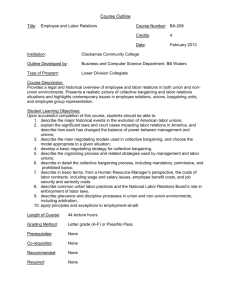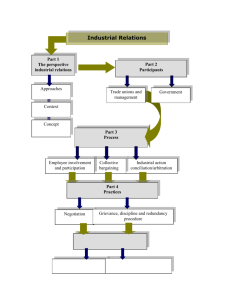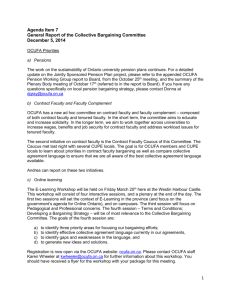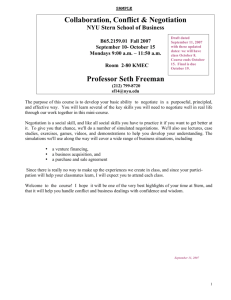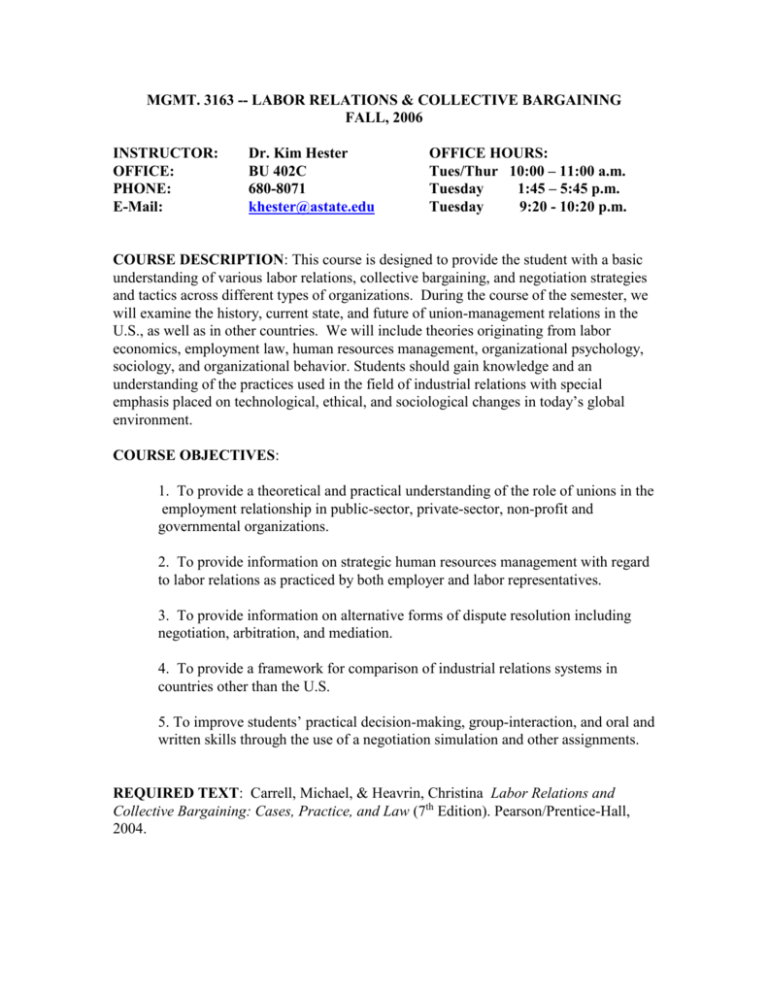
MGMT. 3163 -- LABOR RELATIONS & COLLECTIVE BARGAINING
FALL, 2006
INSTRUCTOR:
OFFICE:
PHONE:
E-Mail:
Dr. Kim Hester
BU 402C
680-8071
khester@astate.edu
OFFICE HOURS:
Tues/Thur 10:00 – 11:00 a.m.
Tuesday
1:45 – 5:45 p.m.
Tuesday
9:20 - 10:20 p.m.
COURSE DESCRIPTION: This course is designed to provide the student with a basic
understanding of various labor relations, collective bargaining, and negotiation strategies
and tactics across different types of organizations. During the course of the semester, we
will examine the history, current state, and future of union-management relations in the
U.S., as well as in other countries. We will include theories originating from labor
economics, employment law, human resources management, organizational psychology,
sociology, and organizational behavior. Students should gain knowledge and an
understanding of the practices used in the field of industrial relations with special
emphasis placed on technological, ethical, and sociological changes in today’s global
environment.
COURSE OBJECTIVES:
1. To provide a theoretical and practical understanding of the role of unions in the
employment relationship in public-sector, private-sector, non-profit and
governmental organizations.
2. To provide information on strategic human resources management with regard
to labor relations as practiced by both employer and labor representatives.
3. To provide information on alternative forms of dispute resolution including
negotiation, arbitration, and mediation.
4. To provide a framework for comparison of industrial relations systems in
countries other than the U.S.
5. To improve students’ practical decision-making, group-interaction, and oral and
written skills through the use of a negotiation simulation and other assignments.
REQUIRED TEXT: Carrell, Michael, & Heavrin, Christina Labor Relations and
Collective Bargaining: Cases, Practice, and Law (7th Edition). Pearson/Prentice-Hall,
2004.
Ability Area Objectives:
1. Communications:
A. Written: You will be required to demonstrate your ability to write two or
more paragraphs that flow together with appropriate transition terms. These are
LEVEL 3 writing requirements and will be conducted at least four times during
the semester. These requirements may be evaluated in class, as homework, in
projects, or as part of examinations.
B. Oral: You will be required to demonstrate your ability to speak clearly using
appropriate grammar by defending your position, or comparing two or more
solutions, or explaining an issue. These are LEVEL 2 speaking requirements and
may be combined all or in part with paragraph 1A above.
C. Interpersonal/Leadership Skills: You are expected to present a positive
attitude by meeting your responsibilities to your class. These would include
meeting class deadlines, being punctual, attending class, and providing leadership
and support to your class colleagues when completing assigned projects. These
are LEVEL 2 minimum skills and may be combined with paragraph 1A and 1B
above.
2. Problem-Solving (Opportunity Development) and Decision-Making: You
will be required to demonstrate your ability to recognize both HR problems and
management opportunities. This may require you to both define what the
problem/opportunity is, or perhaps what the problem/opportunity is not. These
are LEVEL 2 minimum requirements and may be combined with paragraph 1A,
1B, and 1C above.
3. Multi-Media and Technology: You will be required to demonstrate your
ability to use basic technology to include such resources as the online library
catalog; internet browser and search engines; data presentation techniques to
include hard copy and word processing output. These are LEVEL 2 minimum
requirements and may be combined with paragraph 1A, 1B, 1C and 2 above.
4. Ethics: You will be required to demonstrate to recognize ethical issues
involved in making management decisions. This may require you to both
define the ethical issues, and explain your course of action when confronted
with ethical problems. These are LEVEL 2 minimum requirements, and may
be combined with paragraphs 1A, 1B, and 1C above.
CONDUCT OF THE COURSE: Attendance will be taken. Any class activities that
contribute to the course grade cannot be made up if missed. We will be viewing
films, conducting class exercises, and engaging in classroom discussions that you
will be responsible for on your tests and in your negotiation simulation exercise.
Disability: If you have a learning disability or physical disability that may affect
your performance in the classroom, please contact the Disabilities Center on
the ASU campus.
Cheating: Each student is expected to work independently on all exams and
assignments. Each student is obligated to neither participate in, nor condone,
any dishonest activity. Cheating includes but is not restricted to, both giving
and receiving assistance. Any dishonest activity discovered by the instructor
will result, at a minimum, of a grade of zero for that exam or assignment. Further
disciplinary action will be taken by the university administration.
MAJOR TESTS AND ASSIGNMENTS: There will be three examinations, and a team
negotiation simulation. Each student must actively participate in the simulation as
part of a team through both the actual negotiating session and all prior preparation
work. No credit will be given for any student that fails to participate in the
scheduled simulation session between the teams. Normally, each member of the team
will receive the team’s overall grade. However, your peers will also grade you on your
contribution to the total team project. The team evaluation will figure heavily into your
final grade for the simulation exercise!!
Grading: Course grades are based on the following:
Exam # 1
Exam # 2
Exam # 3
Negotiation Simulation
25%
25%
25%
25%
LABOR RELATIONS & COLLECTIVE BARGAINING COURSE OUTLINE
(FALL, 2006)
CHAPT
HOURS PER TOPIC
TOPIC CONTENT
1
10
Outlines the roots of the American labor
movement and the growth of national unions
2&3
6
Provides a thorough understanding of
workplace challenges; discusses labormanagement cooperation and teams; traces
the growth in unions; defines the bargaining
unit and certification process, while
outlining the role of the National Labor
Relations Board
4
3
Introduces and discusses the role and
influence of competing strategies by the
company/union in the election process;
discusses unfair labor practices
5&6
6
Outlines the negotiation process and
different bargaining techniques; explains the
wage concerns and wage issues in collective
bargaining process
7
3
Discusses employee benefits and importance
to parties in negotiation process
8
3
Explores in depth the issue of job security
and seniority for unions
9
3
Explores the implementation of the
collective bargaining agreement, along with
a discussion of contract enforcement
10 & 11
9
General discussion of the grievance and
disciplinary process, highlighting the
arbitration process and its role in industrial
democracy in the workplace
12
3
Discusses unions and equal employment
issues relating to union membership
46


![Labor Management Relations [Opens in New Window]](http://s3.studylib.net/store/data/006750373_1-d299a6861c58d67d0e98709a44e4f857-300x300.png)

